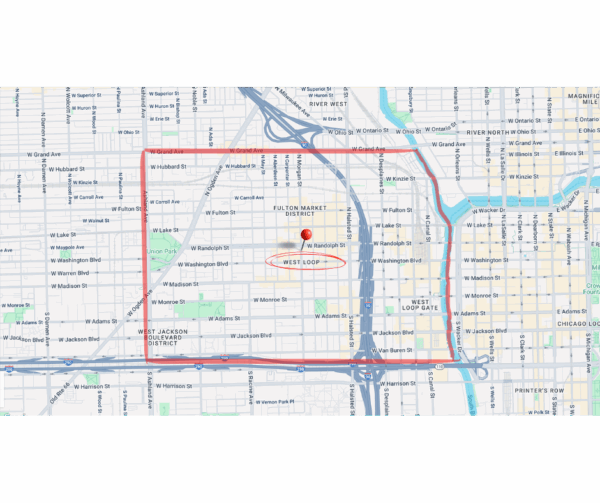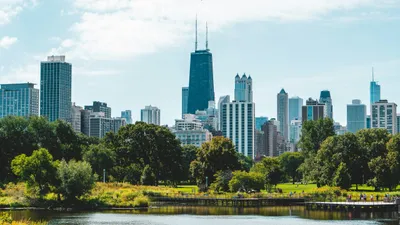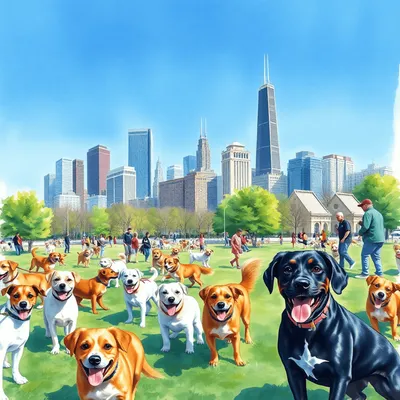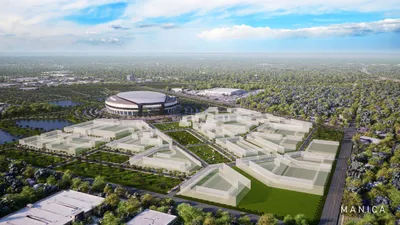Stand on the corner of Randolph and Halsted, and you’ll witness something remarkable: a neighborhood that’s managed to bottle lightning. The West Loop in 2025 isn’t just another Chicago success story—it’s a masterclass in urban reinvention that somehow kept its soul intact.
This slice of Chicago, Illinois has transformed from a gritty meatpacking district where blood ran through the gutters to one of the most sought-after addresses in the Midwest. The old warehouses that once housed cattle carcasses now shelter Michelin-starred restaurants where diners drop hundreds on tasting menus. The loading docks where workers unloaded sides of beef have become patios where tech executives sip natural wine under string lights.
What makes the West Loop Chicago’s most compelling neighborhood isn’t just the food—though yes, this is truly a food lover’s mecca where culinary pilgrims embark on their journey. It’s the way the neighborhood wears its history like a well-loved leather jacket: visible, authentic, and somehow cooler for all the wear.
This guide will walk you through everything that makes the West Loop tick in 2025—from the restaurants that put it on the map to the real estate trends shaping its future, from hidden cultural gems to the corporate giants calling it home. Whether you’re planning a weekend visit or considering a move, you’re about to discover why this neighborhood has become Chicago’s most dynamic destination.
A Brief History of West Loop
The story of West Loop begins not with celebrity chefs or boutique hotels, but with blood, sweat, and the unmistakable smell of livestock. Since the 1850s, the Fulton-Randolph Market area served as the beating heart of Midwest commerce, where cattle cars rolled in and fortunes were made in the meatpacking trade. The neighborhood’s industrial infrastructure—those wide streets designed for loading docks and those sturdy brick warehouses built to last centuries—weren’t architectural choices made for Instagram aesthetics. They were practical necessities for an area that literally fed a growing nation.
The Labor Movement and Its Impact
Walk through West Loop today and you’re treading on ground that witnessed one of America’s most pivotal labor movements. The Haymarket Square Riot of 1886 erupted just blocks away, when a peaceful labor rally demanding an eight-hour workday turned violent after a bomb exploded near police lines. Seven police officers and at least four civilians died. Eight anarchists were convicted in a trial that historians still debate for its fairness. The event sent shockwaves through the American labor movement, simultaneously inspiring workers’ rights advocates worldwide while giving ammunition to those who feared organized labor. That tension—between workers and management, between progress and tradition—became woven into the neighborhood’s DNA.
West Loop’s Role in Chicago’s Industrial Revolution
The late 19th and early 20th centuries saw West Loop cement its role in Chicago’s industrial revolution. The Union Stockyards and Maxwell Street Market turned this area into a commercial powerhouse. Immigrant workers—Irish, Italian, Greek, Polish—flooded into the neighborhood, creating ethnic enclaves that would shape the area’s character for generations. These weren’t just workers; they were families building communities in the shadow of smokestacks and slaughterhouses.
Recognition and Challenges
The Plan of Chicago in 1909 recognized the area’s importance, but the Great Depression hit hard. Parts of West Loop deteriorated into Skid Row, a far cry from today’s gleaming developments. Yet those industrial structures remained, waiting for someone to see their potential.
The Shift
The lively West Loop you see today—full of foodie hotspots and startup buzz—didn’t materialize overnight. Back in 1988, everything changed: Oprah Winfrey opened Harpo Studios at 1058 West Washington Boulevard, making the area famous as her talk show took off. Meanwhile, nearby at the old Chicago Stadium, the Bulls’ playoff runs electrified the neighborhood until the United Center—“the house that Jordan built”—took over.
Before Michelin stars and tech startups arrived, it was Michael Jordan and the Bulls who drew global attention and money, turning industrial warehouses into prime real estate and transforming a gritty district into a cultural and commercial hub. Next time you’re sipping a latte on Randolph or cheering at a Hawks game, remember: it all began with a hometown hero and a dream soaring above the rim.
West Loop’s Geographic Boundaries

West Loop’s prime location just west of Chicago’s downtown core offers the perfect balance of urban sophistication and neighborhood comfort. Defined by distinct boundaries, this former industrial district has evolved into one of the city’s most desirable and dynamic areas.
North: Grand Avenue
West Loop’s northern edge is marked by Grand Avenue, a key diagonal corridor that connects the neighborhood to Fulton Market and River West. Along this stretch, old warehouses meet modern developments, hosting everything from innovative restaurants and boutique fitness studios to sleek office spaces. Grand Avenue also offers convenient access to major routes like Halsted and Ogden, linking residents to surrounding neighborhoods and expressways.
South: Eisenhower Expressway (I-290)
The Eisenhower Expressway defines West Loop’s southern border, providing quick access to Chicago’s western suburbs and downtown business district. This boundary marks a shift from the neighborhood’s vibrant dining and nightlife scene to the more residential and university-focused areas around the Illinois Medical District and University Village.
East: Kennedy Expressway (I-90/94)
On the east side, the Kennedy Expressway creates a natural border separating West Loop from the downtown Loop and Greektown. Just beyond the expressway lies the city’s central business district—making this boundary one of the most convenient for commuters. Bridges over the expressway connect residents directly to the heart of downtown while preserving the neighborhood’s slightly quieter, more residential feel.
West: Ashland Avenue
Ashland Avenue marks the western edge of the West Loop. Beyond this line, the landscape transitions into the Near West Side, offering a mix of classic Chicago architecture and newer residential developments. Within this western corridor, you’ll find expanding green spaces, community parks, and growing sections of the Fulton Market District continuing their westward evolution.
West Loop’s geographic boundaries frame a neighborhood celebrated for its culinary excellence, cutting-edge design, and walkable streetscape. Once home to warehouses and factories, it’s now a hotspot for Michelin-starred restaurants, boutique hotels, modern lofts, and world-class offices—all within minutes of Chicago’s downtown core.
Real Estate Trends Shaping West Loop’s Future
The West Loop real estate development boom following the recession transformed this once gritty industrial corridor into one of Chicago’s most sought-after neighborhoods.
Rapid Residential Growth:
Developers quickly recognized the potential in West Loop’s sprawling warehouses and vacant lots. These spaces were repurposed into luxury lofts, modern condos, and townhomes, attracting a wave of new residents seeking urban convenience with a historic twist.
Commercial Revitalization:
Tech firms, creative agencies, and boutique retail brands established offices in converted industrial buildings. The area’s adaptive reuse trend not only preserved many original architectural elements—such as exposed brick and timber beams—but also added a layer of authenticity and charm.
Culinary Hotspot:
West Loop’s transformation included the emergence of the famed Restaurant Row on Randolph Street. Michelin-starred restaurants and artisanal bakeries have replaced old loading docks, making the neighborhood a destination for food enthusiasts citywide.
Walkability and Amenities:
Planners prioritized pedestrian-friendly streetscapes, green spaces like Mary Bartelme Park, and convenient public transit access. This focus enhanced day-to-day life for residents and positioned West Loop as a model for urban renewal in Chicago.
What’s Happening in the West Loop Housing Market Right Now
The West Loop housing market in 2025 feels like a tightrope walk between past bidding wars and newfound options. It’s no buyer’s utopia yet, but gone are the gladiator days.
2025 Snapshot:
- Median sale price: $540,000 (up 9.9% YoY)
- Average days on market: 36
- Market type: Still favors sellers, but supply is up
- Median rent: $2,598 (80% pay $2K+)
With Google and McDonald’s nearby and a Walk Score of 98, demand stays strong. Limited new builds mean scarcity, though 1,700+ luxury apartments have bumped inventory, giving buyers more choices. Now, 46.4% of homes close below asking, a big shift from years past.
If you bought ten years ago, congrats: condos are up nearly 90%, single-family homes 86% since 2015. The market is slowly balancing—both buyers and sellers can breathe.
The 2025 West Loop Housing Market: Strength & Opportunity
Prices remain high, but the frenzy has eased. Listings last about five weeks now; inventory is up almost 29% month-over-month, giving buyers real options—but demand persists.
Renters feel pressure too: with rents near $2,600 (most pay over $2K), living here is still a commitment.
Who lives here? Mostly affluent professionals averaging $113K incomes; nine in ten have degrees. About two-thirds rent; one-third own—drawn by luxury towers and urban energy.
By The Numbers
- Median sale price: Up ~10% YoY; price per sq ft up ~4%
- Average days on market: Up nearly 8%
- 66% of homes sell within 30 days
- Negotiations: 46% sell below ask; 45% above; only ~10% at list price
- Inventory: Up nearly 29%
Ten Years That Changed Everything
A decade ago, West Loop was “up-and-coming.” Three growth phases shaped today’s market:
- 2015–2019: Rapid growth (7–9%/year) as big employers moved in.
- 2020–21 Pandemic: Steady growth (2–3%) amid broader uncertainty.
- 2022–2025: Another surge (6–8%) as demand spiked post-pandemic.
Corporate HQs fueled jobs; Restaurant Row brought buzz; tight boundaries kept supply low and prices rising—even through COVID.
What’s Next?
Expect steady gains of 4–6% annually through at least 2030 as rates stabilize and inventory balances out. Affordability challenges grow, competition stiffens, construction costs rise—but corporate anchors remain and land to build on remains limited.
Look for rent trends to shift as thousands of new apartments give renters leverage after years of sticker shock.
Bottom line: West Loop isn’t cooling—it’s settling into sustainable growth after a wild decade. Whether buying your first loft or cashing out on appreciation, this neighborhood remains Chicago real estate’s hot story—a place where ambition meets opportunity.
Focus on Low to Mid-Rise Buildings
What distinguishes the West Loop from Chicago’s other fast-changing neighborhoods isn’t just new restaurants or tech companies—it’s the skyline. Rather than building glass towers, the West Loop features low- to mid-rise buildings and very few single-family homes & walk up buildings. This was a conscious choice to preserve the area’s gritty industrial character—weathered brick and timber beams—while managing the post-2008 growth. The result is a community rooted in its past yet responsive to urban demands.
The West Loop: A Food Lover’s Paradise
Walk down Restaurant Row Randolph Street on any given evening, and you’ll understand why food critics from Tokyo to Paris have this stretch bookmarked. The aroma of wood-fired meats mingles with the delicate scent of fresh pasta, while the glow from restaurant windows creates a constellation of culinary possibilities. This isn’t just another dining district—it’s the reason chefs relocate their entire lives to Chicago.
Michelin Star Restaurants and Fine Dining
The Michelin star restaurants West Loop has attracted reads like a who’s who of American fine dining. Here are some notable ones:
⭐️⭐️⭐️
Smyth, where husband-and-wife team John and Karen Shields create dishes that taste like love letters to seasonal ingredients.
⭐️⭐️
Oriole serves a tasting menu so meticulously crafted that diners have been known to photograph every single course (and yes, the lighting is perfect for it).
Ever an innovative 8- to 10-course tasting menu crafted by Chef Curtis Duffy.
⭐️
Elske from Chefs David and Anna Posey serving both à-la-carte dishes and a refined tasting menu featuring Scandinavian-inspired New American dishes.
Mako an intimate omakase served by Chef B.K. Park
Next ever-evolving, themed tasting menu experience from Chef Grant Achatz.
Sepia Chef Andrew Zimmerman’s seasonal menu combines American cuisine with influences from Southeast Asia, Korea, and the Mediterranean.
Diverse Dining Options
But here’s the real magic trick this neighborhood pulls: one night you’re splurging $300 on a tasting menu that could make a Parisian chef weep, and the next you’re elbow-deep in world-class burgers or slurping fiery ramen in the basement of an old warehouse that smells faintly of soy sauce and adventure. Maybe lunch finds you at a fourth-generation Italian importer—once famous for wheels of Parmigiano, now reinvented as the city’s holy grail for subs so good they’ll make you forget your own name. From glitzy steakhouses to hole-in-the-wall pizzerias, taco joints spinning greasy trompos of al pastor, and Italian as authentic as nonna’s kitchen—this corner of the city doesn’t just dabble in every cuisine. It masters them all.
For a deeper dive into the West Loop’s dining scene, check out The Infatuation & Eater’s guide’s.
Experiencing the Neighborhood Lifestyle Beyond Dining
West Loop’s transformation extends far beyond its restaurant-lined streets. The neighborhood has cultivated a lifestyle that blends industrial grit with modern sophistication, creating spaces where residents and visitors can experience Chicago from entirely new perspectives.
Major Employers Driving Economic Growth in the Area
The transformation of West Loop from industrial district to economic powerhouse reads like a corporate relocation wish list. Google’s Midwest headquarters anchors a constellation of Fortune 500 companies that have planted flags in the neighborhood, turning former meatpacking warehouses into gleaming office campuses.
The tech giant’s presence catalyzed a domino effect of corporate migrations:
- McDonald’s Global Headquarters: developed on Oprah’s former Harpo Studio’s lot.
- Mondelez International relocated its global headquarters in 2020.
- Dyson upgraded their US headquarters in 2017
- Accenture has been a staple of West Loop Gate since 1987
- Motorola Solutions global headquarters opened in 2016
- John Deere relocated in 2022.
This concentration of major employers has created an ecosystem where young professionals live, work, and play within a ten-block radius. These companies didn’t just bring jobs—they brought thousands of employees with disposable income, fueling the restaurant boom and residential development that defines modern West Loop.
Transportation Accessibility: Getting Around in West Loop
The neighborhood’s transformation into a corporate and cultural powerhouse didn’t happen by accident—it required serious infrastructure planning. Back in the mid-1990s, Chicago knew the world would be watching when the Democratic National Convention rolled into town in 1996. The city seized that moment to pump millions into Kennedy Expressway infrastructure improvements Chicago neighborhoods desperately needed, particularly in areas like West Loop that would see heavy traffic flows.
Those upgrades laid the groundwork for what residents and visitors enjoy today: a neighborhood that’s remarkably easy to navigate whether you’re on foot, bike, or public transit. The CTA’s Green and Pink Lines slice through the area with multiple stops along Lake Street, connecting West Loop to the Loop proper in minutes. The Blue Line runs parallel along Congress Parkway, offering another rapid transit option for commuters heading downtown or to O’Hare.
For drivers, the proximity to both I-290 and I-90/94 means you’re never more than a few blocks from major expressways. But here’s the thing: many West Loop residents rarely use their cars. The neighborhood’s walkability score consistently ranks among Chicago’s highest, with wide sidewalks, pedestrian-friendly intersections, and bike lanes threading through the streets. Divvy bike-share stations dot nearly every corner, and ride-sharing pickup zones are strategically placed outside popular restaurants and hotels.
Vibrant Entertainment Scene & Community Events Throughout the Year
The West Loop is full of energy all year round. During the day, it’s a busy area for businesses, but at night it turns into a fun place where live music fills the streets and community gatherings bring neighbors together. Kaiser Tiger’s outdoor seating area becomes a popular spot on its own, hosting live bands that attract crowds enjoying craft cocktails under string lights. In the winter months, this same space transforms into Chicago’s most surprising curling venue—because nothing says “urban sophistication” quite like sliding stones across ice between warehouse walls.
Seasonal Street Festivals
Throughout the year, various street festivals take place in the West Loop, celebrating the neighborhood’s transformation from an industrial past to a vibrant culinary present:
- Randolph Street Market Festival: Vintage collectors, artisans, and food vendors come together in a large celebration of creativity in the area.
- Restaurant Row summer events: These events highlight the culinary talent that put West Loop on the international food map.
- Holiday markets: Parking lots are transformed into European-style shopping experiences with mulled wine and handcrafted gifts.
Annual Music Festivals
Union Park, which anchors the west end of the neighborhood, plays host to several music events each summer anchored by Arc Music Festival an electronic dance music festival every Labor Day weekend, celebrating Chicago’s house music heritage
The Future Of West Loop: Anticipated Developments And Trends Beyond 2025
The West Loop’s transformation shows no signs of slowing down. Developers are betting big on the neighborhood’s continued appeal, with approximately 850 new hotel rooms slated to open within the next two years. This aggressive expansion reflects something undeniable: tourists want to wake up in the heart of Chicago’s most dynamic neighborhood, not just visit it for dinner.
These planned hotel developments West Loop projects aren’t random. They’re strategic responses to a fundamental urban lifestyle shift Chicago has embraced—people crave walkable, mixed-use neighborhoods where they can live, work, and play within a few blocks. The West Loop has become the poster child for this movement, and hospitality investors are racing to claim their stake.
What makes this growth particularly interesting is the neighborhood’s commitment to preserving its character. While other Chicago districts have succumbed to glass-tower fever, the West Loop maintains strict low-to-mid-rise zoning regulations. Drive down Randolph or Fulton Market, and you’ll notice buildings that complement rather than overwhelm the historic warehouse architecture. This isn’t accidental—it’s intentional urban planning that balances Chicago real estate trends with community identity.
The tourism growth here tells a compelling story about what travelers value in 2025. They’re choosing neighborhoods with authentic character over generic hotel districts. They want to stumble upon a fourth-generation sandwich shop, not another chain restaurant. They’re seeking cultural venue expansions that showcase local artists, not imported entertainment.
Developers understand this delicate balance. The challenge ahead isn’t just adding capacity—it’s maintaining the gritty-meets-polished aesthetic that made the West Loop special in the first place. Those converted meatpacking warehouses? They’re not just trendy backdrops; they’re the neighborhood’s DNA.
The West Loop’s future depends on remembering its past while embracing its present. If developers can resist the temptation to over-build and city planners hold firm on zoning restrictions, this neighborhood will continue thriving as Chicago’s most compelling destination for years to come.


